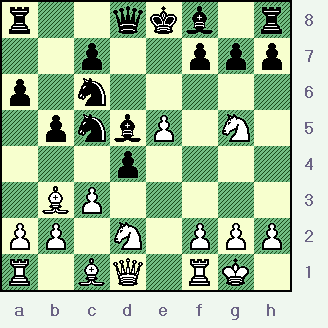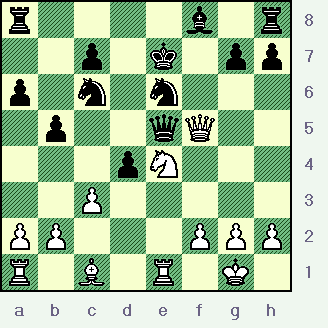All
the |
(Navigation bar
directly below.)
*******
© A.J. Goldsby, 2015.
(All rights reserved.)
****************
Click HERE
to see my
Chess Items.
****************
****************
Buy a book
from Amazon.com
(And help me out as well!)
****************
Click HERE
...
to see a list of the businesses that help to sponsor all of
my chess efforts.
Another great chess game ... by Judit Polgar
GM
Judit Polgar (2685) - GM Shakhriyar Mamedyarov
(2580)
|
|
|
[A.J.G.]
Replay this game HERE, (on another website).
See an explanation of the various symbols that I use when annotating a chess game.
Perhaps one of the most amazing games that I have ever seen, especially one that is of a relatively recent vintage. Please note that the GM playing Black is currently the number seven (#7) player in the whole world, and is rated 2752. (See the FIDE "Top 100" rating list for the period of October, 2007.)
{The ratings given here are accurate and were those assigned to this contest when I downloaded it {UN-annotated} from the ChessBase website.)
1.e4 e5;
2.Nf3 Nc6; 3.Bb5,
The Ruy Lopez remains one of the most popular of all openings ... for both the amateur and the GM
alike.
3...a6;
4.Ba4 Nf6; 5.0-0 Nxe4; 6.d4 b5; 7.Bb3 d5; 8.dxe5 Be6;
This is the main line of the system known as "The Open Variation" of the Ruy Lopez.
[See MCO-14, beginning on page # 70, for more information and analysis on this
particular branch of this opening.]
9.Nbd2,
This seems to be the best way for White to proceed, and the path that most GM's take nowadays.
[ Another way for White to proceed is to play the following line:
9.c3 Bc5; 10.Nbd2 0-0;
"~" with highly complex play.
One example would be: M. Carlsen - L. Fressinet; Cap d'Agde (KO) /
2006.
{White won, 1-0 in 27 moves.} ]
9...Nc5;
For many years, this was one of Black's time honored main lines.
[ Another recent game went as follows:
9...Be7; 10.c3 0-0; 11.Re1 Nc5;
12.Nd4 Nxd4;
13.cxd4 Nd3; 14.Re3 Nxc1; 15.Rxc1, "+/="
White is already slightly better.
15...c5!?; Otherwise Black is left with the backward Pawn on the c-file.
16.dxc5 Rc8; 17.Rec3 b4;
18.R3c2!?, (Maybe - '!!')
White plays to maintain the extra Pawn on the c-file. Apparently Shirov is happy to surrender
the Exchange as he gets to keep the initiative for a very long time.
(Instead, after the moves: 18.Rd3 Bxc5!?; 19.Ne4 Bb6;
20.Rxc8 Qxc8; 21.Nd6, "/\"
White maintains the upper hand.)
18...Bf5; 19.c6 Bxc2;
20.Rxc2 Qa5;
Possibly b6 was a better square.
21.Nf3 Rfd8; 22.Nd4 g6!?;
Played to keep a Knight off the f5-square, but the long-term damage to the King-side Pawn
structure will turn out to be a real headache for Black.
(Fritz likes 22...Qc7 here.)
23.e6! Bf6; 24.exf7+ Kxf7;
25.h4! Qb6; 26.Rd2 Rd6?!;
This was not a wise choice.
(The best defense was:
>/= 26...Bxd4; 27.Rxd4 Rxc6; 28.Rxd5, "+/=" when White is still probably a little better.)
27.Nf5!! Rdxc6;
Black is now forced to return some of his ill-gotten gains.
(</= 27...gxf5?; 28.Rxd5 Rdxc6!?; 29.Qh5+! Ke7; 30.Qxh7+ Ke8; 31.Rd1!, "+/-" )
The rest is just mopping up.
28.Bxd5+ Kf8; 29.Bxc6 Rxc6;
30.Ne3 Bxh4; 31.Qf3+ Rf6!?; 32.Qa8+ Kg7;
33.Qe4 b3;
34.axb3, "+/-" Black Resigns, 1-0.
GM Alexei Shirov (2739) - GM Magnus Carlsen
(2714); /
The "Tal Memorial" Tnmt. (R#6)
/ Moscow, RUS /
Nov, 2007. Replay
this game. ]
10.c3 d4!?;
11.Ng5!, (Maybe - '!!')
This idea, originally a brilliant shot from Karpov's trainer, (I Zaitsev); it was first used by Karpov (against Korchnoi) in their hotly contested World Championship Match. {See the tenth game of the World Championship match in 1978,
that game was drawn in forty-four total moves.} Possibly the best game of the db would be the tenth match game between Garry Kasparov and Viswanathan Anand. [New York, 1995.] {This
game was a smashing win for Garry and one the most exceptional and brilliant games of chess ever played.}
[ The continuation of:
11.Bxe6 Nxe6; 12.cxd4 Ncxd4;
13.Ne4 Be7; 14.Be3, "~" ("+/=")
(also) gives White great play.
See the following historic struggle:
GM Anatoly Karpov
(2700) - GM Viktor Kortschnoj
(2695);
The 30th (FIDE)
World's Championship / Merano,
Italy; (R #14) / 10,1981.
{White won a tough, but sharp game, 1-0 in forty-six
cutting moves.}
]
11...Bd5?!;
Black chooses a seemingly natural looking defense, but one that allows a truly stunning refutation.
|
|
r2qkb1r/2p2ppp/p1n5/1pnbP1N1/3p4/1BP5/PP1N1PPP/R1BQ1RK1 w
Study this position carefully ... and see if you can guess how Judit will proceed from this position.
[ Or (>/=) 11...Qxg5; 12.Qf3, "+/=" and White will regain the piece and maintain a superior position.
Perhaps the best example of this position would have to be:
GM Garry Kasparov (2849) - GM Alexei Shirov (2718); /
18th Super-GM Tournament /
Linares,
ESP; (R#8) / 23,02,2001. /
{Garry won a smashing
victory, 1-0 in 38 total moves.} ]
12.Nxf7!! Kxf7;
13.Qf3+ Ke6[];
This is forced for Black, otherwise White simply regains the piece and keeps an extra Pawn as well.
[ But of course not: </= 13...Kg8??; 14.Qxd5+ Qxd5; 15.Bxd5+ Ne6; 16.Bxe6#. ]
14.Qg4+ Kf7!?;
(hmmm)
The best defense was probably 14...Ke7; although opening analysis (in several books) proves that Black would not be able to safely extricate his King from the center of the board.
[ Even worse would be:
</= 14...Kxe5?; 15.Nf3+! Kd6;
16.Bf4+ Ke7; 17.Rae1+ Be4;
18.Rxe4+ Ne5[];
This is forced.
(Or if: 18...Nxe4; then 19.Qe6#.)
19.Nxe5 Kd6; 20.Rxd4+ Ke7; 21.Bg5+ Ke8; 22.Bf7#.
**********************************************************************************************
For the game with the move of: 14...Ke7;
see the GM contest ... ... ...
GM Peter Svidler (2713) - GM Viswanathan Anand (2781); /
Super GM Tournament
Dos Hermanas,
ESP; (R#5) / 04,1999.
{The game was eventually drawn, although White may have missed a win at the very end.}
]
Now White can win material (back) with e6+ and then Qf3+, however Judit's focus is entirely on Black's King ... and nothing else.
15.Qf5+! Ke7!?;
Some annotators have labeled this move as an error, however 15...Kg8; 16.e6, is a relatively easy win for White.
(Fritz 'thinks' that 15...Ke8 is best, but also shows that White is clearly winning in that line as well.)
Now - when I first went over this game - I thought that Nf3 (or even Rd1) was the correct way for White to proceed.
(However, Judit finds a much better way.)
16.e6! Bxe6;
17.Re1!!,
Absolutely the best line for White.
[ Or (instead) the continuation of: </=
17.Qxc5+ Qd6; 18.Qh5, "+/-"
wins material for White,
but allows the attack to lose a lot of its steam.
]
17...Qd6;
18.Bxe6! Nxe6; 19.Ne4! Qe5[];
It looks downright dumb for Black to stick his Queen on the same file as the White Rook. However, Fritz confirms that this was indeed forced, and that the alternatives were worse.
|
|
r4b1r/2p1k1pp/p1n1n3/1p2qQ2/3pN3/2P5/PP3PPP/R1B1R1K1 w
The end is near, those who are a bit squeamish ... should cover their eyes.
(And also put your thumbs in your ears, to block out the blood-curdling
screams.)
(A fall reference ... I
originally intended to post this game about mid-October, 2007 ... but
things did not work out that way. - ye olde editor)
[ The alternative line of:
</= 19...Qd7?; 20.Nc5, "+/-"
was simply too ugly for Black to seriously consider.
]
20.Bg5+ Kd7;
{Box}
This was forced, playing to e8 would allow White to play Nf6+, which wins Black's Queen.
21.Nc5+! Bxc5;
22.Qf7+! Kd6;
(22...Kc8 was only marginally better, and also still losing ... by a fairly substantial margin.)
23.Be7+!,
In my mind, this is one of the prettiest miniatures of modern times and definitely one of my
favorite games of Judit Polgar.
(It highlights her exceptional tactical skill in sharp attacks.)
To see this game
thoroughly annotated,
please see the excellent book,
"50 Essential Chess Lessons," by
FM Steve Giddins.
(Game # 3, beginning on page # 14.)
---> Note that several sources give Black as playing 23...Kd5; ('?') when White can then mate in just three more moves.
Copyright (c) A.J. Goldsby, 2007. All rights reserved.
1 - 0
This game is not in "The Open Variation," but it is a hot, topical line of the Ruy Lopez.
Click HERE to go (return) to my home page. (For my main GC chess site.)
Click HERE to go (return) to my site map.
Click HERE to return to my page on Judit Polgar.
Click HERE to go to my domain.
*******
This page was created in November 2007, and was first posted on (Tuesday); November 20th, 2007. Final format was completed on Friday; Nov. 23, 2007.
It was last edited on: Wednesday, May 06, 2015 , 04:15 PM .
Copyright (©) LM A.J. Goldsby, 2015.
Copyright (c) A.J. Goldsby, 2015. All rights reserved.

